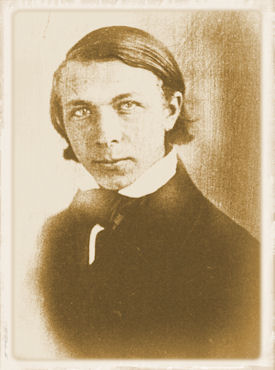

edited by Alois Payer
Cite as:
Kittel, F. (Ferdinand) <1832 - 1903>: A grammar of the Kannaḍa language in English : comprising the three dialects of the language (ancient, medićval and modern). -- 1903. -- 1. Introductory observations. -- Fassung vom 2009-12-15. -- URL: http://www.payer.de/kittel/kittel01.htm
Originally published as:
Kittel, F. (Ferdinand) <1832 - 1903>: A grammar of the Kannaḍa language in English : comprising the three dialects of the language (ancient, medićval and modern). -- Mangalore : Basel Mission Book and Tract Depository, 1903. -- VI, 483 S. ; 24 cm.
The original edition is online available at: http://www.archive.org/details/grammarofKannaḍa00kittuoft. -- Accessed on 2009-12-12
First time published here: 2009-12-13
Revisions: 2009-12-15 [additions]
©opyright: Public domain
This text is part of the department Sanskrit ofTüpfli's Global Village Library
You need a font with diacritica as e.g. Tahoma
Kannaḍa-letters are coded in Unicode. You need a Unicode Kannaḍa font.
Use of brackets:
[] = additions by Alois Payer
1. The term Kannaḍa (ಕನ್ನಡ), the Canarese of European writers, is formed from Kar-nāḍu (ಕರ್-ನಾಡು), the black cultivated country, referring to the black soil, commonly called cotton soil, which characterises the plateau of the Southern Dekkan (ದಖ್ಖನ್). In the Saṃskṛta language the term appears as Karṇāṭa (ಕರ್ಣಾಟ) and Karṇāṭaka (ಕರ್ಣಾಟಕ). Kannaḍa is the appellation of the Canarese country and its language.1
1 'The district of Canara (a corrupted form of Kunnaḍa) on the Western coast got that name because it was subjected for centuries to the rule of Kannaḍa princes, and the Carnatic (i.e. Karṇāṭaka), the country below the Eastern Ghauts on the Coromandal coast, was (by a missaplication of terms) called by that name first by the Muhammedans.
2. Kannaḍa is spoken throughout Mysore, the Southern Mahratta country, in some of the western districts of the Nijam's territory (as far north as Bidar), and partly in North Canara on the western coast. The people that speak the Kannaḍa language are estimated at about nine millions.
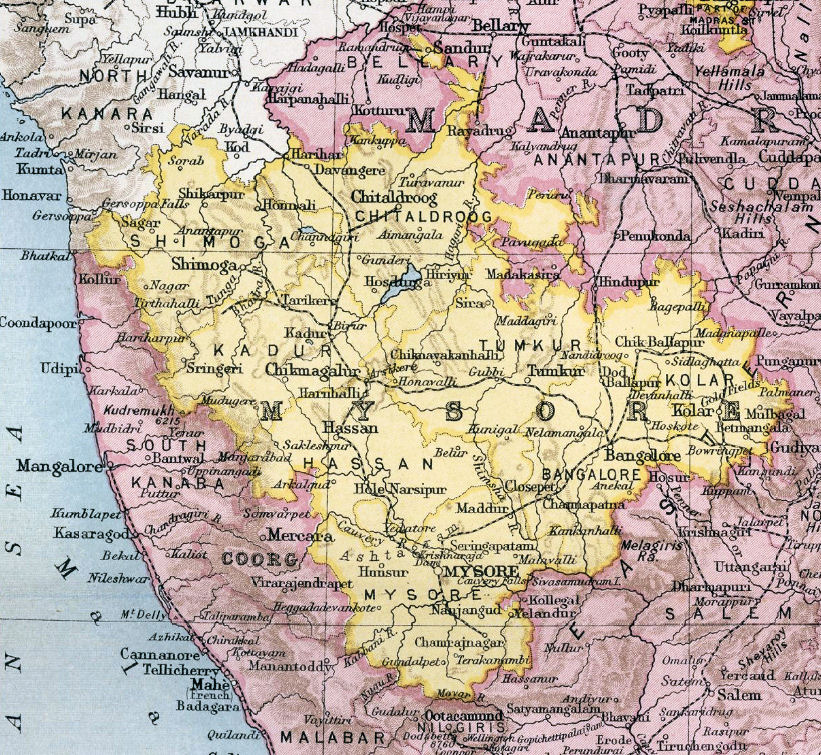
Fig.: The Kingdom of Mysore (ಮೈಸೂರು ಸಂಸ್ಥಾನ maisūru saṃsthāna) and
neighbours
[Source: Imperial Gazetteer of India, 1931 / Wikipedia]
3. The Kannaḍa language belongs to a group of languages which has been called the Dravidian (i.e. ದ್ರವಿಡ or ದ್ರಾವಿಡ) family by European writers. The chief members of this family are Kannaḍa, Telugu ([తెలుగు] ತೆಲುಗು), Tamiḻ ([தமிழ்] ತಮಿಳು), Malayāḷa[m] ([മലയാളം] ಮಲಯಾಳಂ), Tuḷu (ತುಳು), Koḍagu [Koḍava] (ಕೋಡಗು [ಕೊಡವ]), and Baḍaga (ಬಡಗ, on the Nīlagiri).
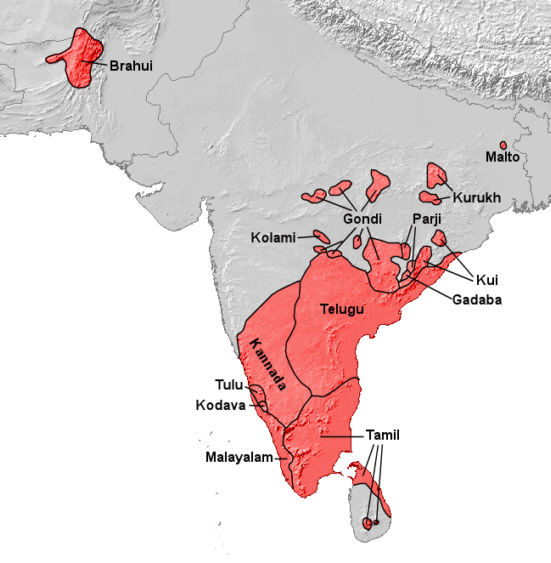
Fig.: Areas where Dravidian languages are spoken
[Source: BishkekRocks / Wikipedia. -- GNU FDlicense]
4. The so-called Dravidian languages have borrowed a great many words from Saṃskṛta, especially such as express abstract ideas of philosophy, science, and religion, together with the technical terms of the more elegant arts, etc. (cf. § 369); but their non-Saṃskṛta portion is considerable, and once was sufficient for ordinary conversation. Chiefly by a comparison of their grammatical structure with that of Saṃskṛta the essential independence of the [p. 2] Dravidian languages of Saṃskṛta can satisfactorily and conclusively be established.
5. The earliest written documents of the Kannaḍa language are inscriptions on walls and pillars of temples, on detached stone-tablets and monumental stones, and on copper-plates of the Canarese country. The inscriptions are often dated ; if they have no date, the form of the letters used and historical references to dated inscriptions serve to ascertain their age.
6. As regards the forms of the Old and Modern Kannaḍa alphabets, they are varieties of the so-called Cave-character, an alphabet which was used for the inscriptions in the cave hermitages of Buddhists in India (e. g. at Salsette [साष्टी], Kānherī [कान्हेरी], Nāsik [नासिक], Sahyādri, Ajānta [अजंठा लेणी]), and rests on the Southern Aśōka character. This character was about 250 B. C. employed in the Edicts of the Buddhist king Aśōka. Different forms of the letters used for the Kannaḍa inscriptions appear at different periods, the earlier forms differing in the greatest degree from those of the Modern Kannada alphabet. At the time of the composition of the Basavapurāṇa 1369 A. D. the old alphabet had become already out of use, as the author of that work mentions the letters of Old Kannaḍa ( ) as belonging to the past.
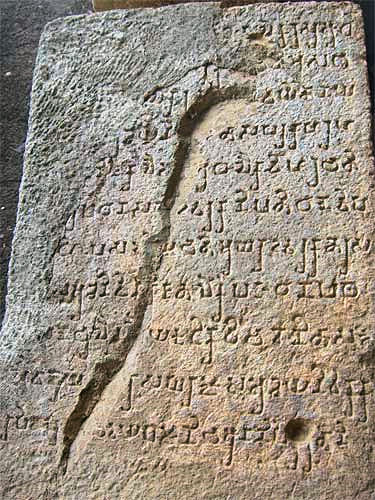
Fig.: Inscription in the Kanheri caves (कान्हेरी गुहा) (near Mumbai)
[Source: Nichalp / Wikipedia. -- GNU FDLicense]
7. The Kannaḍa language in the old inscriptions (of the Kadamba [ಕದಂಬರು], Gaṅga [ಗಂಗ], Cālukya [ಚಾಲುಕ್ಯರು], Rāṣṭrakūṭa [ರಾಷ್ಟ್ರಕೂಟ] and other kings) of which specimens exist that belong to about 600 A. D., is not the same as that of the present day; it is what is called Old Canarese. This Old Canarese is also the language of the early Kannaḍa authors or the literary style. It may be said to have continued in use to the middle of the 13th century (see § 109), when by degrees the language of the inscriptions and literary compositions begins to evince a tendency to become Modern Canarese or the popular and colloquial dialect of the present time. A characteristic of the literary or classical style of the early authors is its extraordinary amount of polish and refinement. The classical authors were Jainas. One of them was Nṛpatuṅga, who wrote the Kavirājamārga (a treatise on [p. 3] alaṅkāra) in the 9th century; another was Pampa or Hampa who composed his Bhārata (an itihāsa more or less based on Vyāsa's Mahābhārata) in 941 A. D.; and a third one was Argaḷa who finished his Purāṇa in 1189 A. D. 1
1 The Kavirājamārga was edited in 1898 by K. B. Pathak, B. A., Assistant to the Director of Archaeological Researches in Mysore, the Bhārata also in 1898 by Lewis L. Rice, C. I. K., M. R. A. S., Director of Archaeological Researches in Mysore. (Mysore Government Central Press, Bangalore.)
8. The grammatical treatises on Kannaḍa were constructed on the Saṃskṛta plan. Their Jaina authors took Pāṇini and others as their guides. The earliest grammarian, whose works have come down to us, is Nāgavarma who appears to belong to the first half of the 12th century. Kēśirāja or Kēśava, the author of a well-known grammar, lived about one hundred years later, in the 13th century. The above-named authors treat on the Old Canarese language, illustrating it by quotations from the writings of former (or contemporary) poets. Nāgavarma wrote his first grammar, an epitome, in Kanda verses and Old Canarese, and embodied it in his treatise on the art of poetry, the Kāvyāvalōkana (in Old Canarese); his second grammar, the Karṇāṭakabhāṣābhūṣaṇa, is in Saṃskṛta prose sūtras, each accompanied by a vṛtti or explanatory gloss also in Saṃskṛta. Kēśirāja's grammar, the Śabdamaṇidarpaṇa, is composed wholly in Kanda verses and Old Canarese (each verse having its prose vṛtti), and is the fullest systematic exposition of that language1.
1 Nāgavarma's Karṇāṭakabhāṣābhūṣaṇa was edited by B. Lewis Rice, M. R. A. S., Director of Public Instruction (Bangalore, Mysore Government Press, 1884). It contains 10 paricchedas, viz.
sańjnāvidhāna,
sandhividhāna,
vibhaktividhāna,
karakavidhāna.
śabdarītividhāna,
samāsavidhāna,
taddhitavidhāna,
ākhyātanigamavidhāna,
avyayanirūpaṇavidhāna and
nipātanirūpaṇavidhāna,
in 280 sūtras.
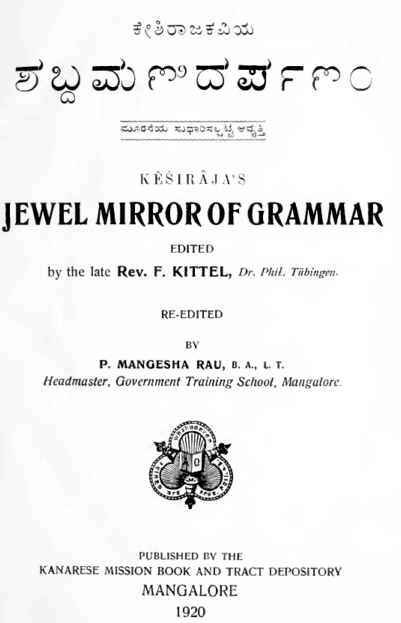
Fig.: Title page of: Kēśirāja <fl. 1260>: Śabdamaṇidarpaṇa / edited by
Ferdinand Kittel ; re-edited by P. Mangesha Rao. -- Mangalore : Kannarese
Mission Book and Tract Depository, 1920. -- 470 p. -- Online:
http://www.archive.org/details/abdamaidarpaa00kirjuoft. -- Accessed on
2009-12-13
An edition of Kēśirāja's Śabdamaṇidarpaṇa was printed at Mangalore (Basel Mission Press. 1872). His work has 8 sandhis or chapters and 322 sūtras. A short summary of its contents is as follows:
Sandhi or euphonic combinations of letters. 1) akṣarasańjnāprakaraṇa or the section of the signs used as letters. a) the letters of the alphabet; b) the vowels in particular; c) the consonants in particular. 2) sandhiprakaraṇa or the section of combination of the mentioned letters, a) combination of vowels; b) combination of consonants.
- Nāma or nominal themes,
- liṅgas or declinable bases,
kṛts or bases formed from verbs by means of suffixes,
taddhita-bases formed from nouns and verbs by means of certain other suffixes,
samāsas or compound bases,
nāmas or ready nouns (distinguished as rūḍha, anvartha and aṅkita; they include the so-called adjectives, pronouns, numerals, and themes from Saṃskṛta, altered or unaltered);
genders;
the seven bases in the singular;
the two numbers;
the augments of the plural;
particularities regarding declension;
uses of the cases;
remarks on number, gender, construction, etc.;
declension of pronouns;
change of gender;
change of letters.
- Samāsa or composition of words, compound bases.
augment, elision, and substitution.
the six classes of Saṃskṛta compounds.
the compounds called kriyāsamāsa, gamakasamāsa, and vīpsāsamāsa.
Taddhita-bases formed from nouns and verbs by means of certain suffixes.
Ākhyāta or verbs and their conjugation.
Dhātu or verbal roots (or themes).
Tadbhava (Apabhraṃśa) or words corrupted from the Saṃskṛta language.
Avyaya or adverbs, etc.
Besides the Karṇāṭakabhāṣābhūṣaṇa there is another grammar of the Old Canarese language in Saṃskṛta sītras, etc., the Karṇāṭakaśabdānuśāsana, written by the Jaina Bhaṭṭākalaṅka, dated A. D. 1604. It was edited by B. Lewis Rice, C. I. B., M. R. A. S., Director of Archaeological Researches in Mysore, late Director of Public Instruction in Mysore and Coorg (Bangalore, Mysore Government Central Press, 1890). According to its learned editor it treats, in the order given, of the alphabet; avyayas; sandhi; nipātas; gender; tadbhavas; case affixes; compound words; uses of personal pronouns; uses of the singular and plural numbers and numerals; taddhitas; verbs and verbal affixes.
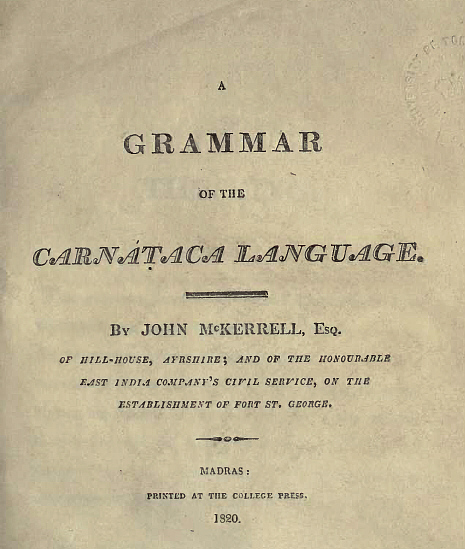
Fig.: Title page of: McKerrell, John: Grammar of the Carnaṭaca language.
-- Madras : College Pres, 1820. -- Online:
http://www.archive.org/details/grammarofcarnata00mckeuoft. -- Accessed on
2009-12-13.
The first grammar of the Canarese language which appeared in English, was compiled by John McKerrell Esq.. M. C. S., who dedicated his work to the King (George IV), Madras, November the 16th, 1820. He calls it "A Grammar of the Carnataka Language". In his Preface he states: "In the course of my labours I have derived much information from a very scarce and accurate treatise upon the ancient dialect, which was compiled, about seven centuries ago. by an Indian author named Céshava, and by him termed ಶಬ್ದಮಣಿದರ್ಪಣಂ or 'The mirror of verbal gems'. ... I feel myself under considerable obligations to Edward Richard Sullivan, Esq., of the Civil Service, for his kindness in procuring for me from His Highness the Rajah of Mysoor the work of Céshava." McKerrell's work has 211 pages.
9. The ancient Kannaḍa grammarians held the study of grammar in high esteem, as may be learned from the following words of the author of the Śabdamaṇidarpaṇa:
"Through grammar (correct) words originate, through the words of that grammar meaning (originates), through meaning the beholding of truth, through the beholding of truth the desired final beatitude; this (final beatitude) is the fruit for the learned" (sūtra 10 of the Preface).
To: II. On the form of the signs that are used as letters